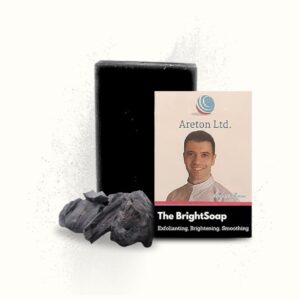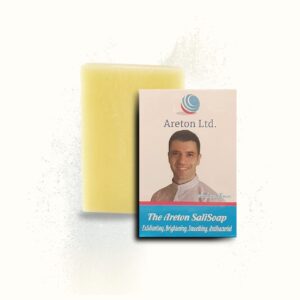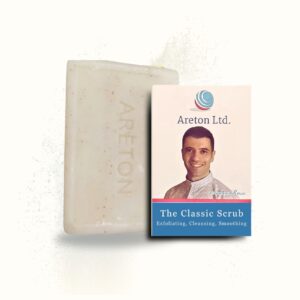Introduction
Soap is one of the most widely used personal care products in the world. It’s an essential part of our daily hygiene routines and helps keep our skin clean. But how exactly does soap work to cleanse our skin?
At its most basic level, soap is made up of molecules with a hydrophilic (water-loving) head and a hydrophobic (water-fearing) tail. This special chemistry allows soap to act as a bridge between oil and water. When we wash with soap and water, the soap molecules surround oil and dirt particles on the skin, breaking them up into micelles with the hydrophobic tails pointed inward and the hydrophilic heads pointed outward toward the water. This allows the oil and dirt to be rinsed away with the water, leaving the skin clean!
The history of soap dates back thousands of years, with the earliest recorded evidence of soap-like detergents found in clay cylinders from around 2800 B.C. in ancient Babylon. Soap making advanced during the Roman Empire, but did not become commonplace until the 19th century.
Today, while the core chemistry remains the same, there are many different types of soap beyond just basic bar soap, including liquid soaps, soaps with added moisturizers, antibacterial soaps, and more specialized soaps like activated charcoal, salicylic acid, and kojic acid soaps. Let’s explore the science behind how these soaps work!
Chemistry of Soap
Soap is made from a chemical reaction between fat/oil and an alkali, usually sodium hydroxide or potassium hydroxide. The fat, which is usually from animals or plants, consists of triglycerides. Triglycerides contain three fatty acids connected to a glycerol backbone.
When the triglycerides in the fat/oil react with the alkali, the fatty acids get separated from the glycerol. The fatty acids then connect with the alkali molecules, creating long chain structures called salts of fatty acids. These salts of fatty acids are the basic component of soap.
The hydrophilic (water loving) head of the salt bonds with water, while the hydrophobic (water fearing) tail bonds with oil and grease. This allows soap to act as an emulsifier that can suspend oil/grease in water and wash it away.
Micelles
Soap molecules have a hydrophilic (water-loving) head and a hydrophobic (water-fearing) tail. When mixed with water, the soap molecules arrange themselves into spherical micelles, with the hydrophilic heads facing outwards towards the water and the hydrophobic tails facing inwards away from the water.
These micelles act like magnets for grease and dirt particles, which are also hydrophobic. The hydrophobic tails of the soap molecules attract and surround the oil and dirt particles, while the hydrophilic heads keep the micelles soluble in water. This allows the micelles to capture and isolate the dirt particles in the interior and wash them away with the water.
The formation of micelles is key to how soap cleans so effectively. Without micelles, the soap molecules would not cluster around dirt and oils to cleanse them from surfaces. The unique chemical structure of soap creates these spherical micelles that powerfully attract and encapsulate grime when washing.
Activated Charcoal Soap
Activated charcoal has become a popular ingredient in skin care products in recent years. Our activated charcoal soap contains activated charcoal powder, which has some unique properties that make it great for cleansing skin.
Activated charcoal is extremely porous and absorbs impurities from the skin. It is able to “trap” chemicals and toxins in its millions of tiny pores. By drawing out impurities, activated charcoal can help detoxify skin. It is often used to treat skin conditions like acne.
The activated charcoal in our soap gently exfoliates to remove dead skin cells and dirt from the skin’s surface. This leaves skin feeling super clean. Activated charcoal also has anti-bacterial properties, which help fight acne.
Our activated charcoal soap has a beautiful black color from the charcoal powder. It lathers into a nice rich foam that leaves skin feeling fresh and smooth. The activated charcoal pulls toxins from deep within pores while gently exfoliating the skin’s surface.
-
 Rated 0 out of 5¡A la Venta!Add to basket
Rated 0 out of 5¡A la Venta!Add to basket$10.00Original price was: $10.00.$5.99Current price is: $5.99.
Salicylic Acid Soap
Salicylic acid is a beta hydroxy acid that is commonly used in skin care products as a chemical exfoliant. In soap, salicylic acid helps remove dead skin cells and excess oil from the skin’s surface. This helps keep pores clear and can improve skin texture.
Our salicylic acid soap contains 2% salicylic acid, which is an effective concentration for cleansing and gently exfoliating the skin. Salicylic acid works by dissolving the bonds that hold skin cells together, allowing the dead cells to be washed away. This helps reveal newer, fresher skin underneath.
Salicylic acid also has anti-inflammatory properties to help reduce redness and calm irritation. By removing debris and oil, salicylic acid helps prevent clogged pores which can lead to breakouts. It is especially beneficial for people with oily and acne-prone skin types.
The soap base allows the salicylic acid to spread easily over the skin and penetrate into pores. As you lather and rinse the soap, the salicylic acid dissolves dead skin cells and pulls out impurities from the skin. With regular use, you may see improvements in skin texture, clarity, and tone.
Our salicylic acid soap provides a deep cleanse while also delivering smoothing and renewing exfoliation. It’s a great choice if you want to target clogged pores, blackheads, breakouts, roughness, and uneven texture. The soap helps reveal fresher, smoother skin by removing layers of built-up dead skin cells.
Kojic Acid Soap
Kojic acid is a natural skin-brightening ingredient derived from mushrooms. It works by inhibiting tyrosinase, an enzyme involved in melanin production that causes skin to darken with sun exposure and age.
Our kojic acid soap contains a high concentration of this brightening ingredient to help minimize the appearance of dark spots, discoloration, and hyperpigmentation. The kojic acid gently exfoliates the skin’s surface while simultaneously brightening.
With regular use, our kojic acid soap can help even out skin tone for a brighter, more radiant complexion. It’s especially beneficial for targeting dark spots, acne scars, melasma, and sun damage. The soap has a light, refreshing scent and produces a rich lather that leaves skin feeling soft and smooth.
Kojic acid is gentler than many other brightening agents like hydroquinone. It’s suitable for all skin types, including sensitive skin. When combined with salicylic acid like in our soap, kojic acid provides exfoliation to enhance penetration of the brightening benefits.
Our kojic acid soap with its skin-renewing and tone-evening properties is the perfect addition to your skincare routine if you’re looking to achieve a glowing, luminous complexion. Kojic acid is a natural alternative to effectively and safely minimize the appearance of discoloration without irritation.
Scrub Soaps
Scrub soaps contain small exfoliating particles that help remove dead skin cells and unclog pores. As we shed old skin cells, they can cling to the skin’s surface and clog pores. Using a scrub soap helps gently remove these dead skin cells and reveal newer, healthier skin underneath.
The exfoliating particles in scrub soaps are often made from natural ingredients like sea salt, sugar, ground nut shells or seeds, oatmeal, or fruit pits. These particles are suspended in the soap base. As you lather and rub the soap over your skin, the particles provide a gentle abrasion to lift away dead cells. This helps prevent buildup that can lead to acne and dull skin.
Scrub soaps tend to be more abrasive than regular soap. They provide an invigorating scrubbing sensation. Most dermatologists recommend using them 2-3 times per week at most. Over-exfoliating with a scrub soap can cause irritation and microtears. It’s best to let the natural exfoliation process take its course in between uses.
Overall, adding a scrub soap into your skincare routine occasionally can revive and refresh dull, congested skin. The exfoliating particles leave skin smoother and clearer by whisking away dead cells and surface debris. Just be careful not to overdo it, as too much scrubbing can do more harm than good.
-
 Rated 0 out of 5¡A la Venta!Add to basket
Rated 0 out of 5¡A la Venta!Add to basket$10.00Original price was: $10.00.$5.99Current price is: $5.99. -
 Rated 0 out of 5¡A la Venta!Add to basket
Rated 0 out of 5¡A la Venta!Add to basket$10.00Original price was: $10.00.$5.99Current price is: $5.99.
Soap pH
Soap has an alkaline pH of around 9-10, while healthy skin has an acidic pH of around 4-6. When alkaline soap is applied to the skin, it causes the skin’s pH to briefly increase and become more alkaline. However, the skin has several natural buffering mechanisms that bring its pH back down into the acidic range shortly after washing.
The outer layer of skin, known as the stratum corneum, contains free fatty acids that help maintain the skin’s acidic pH. There are also acid mantles on the skin’s surface that create acidic conditions. The skin also contains pH regulating enzymes that convert triglycerides in the skin into free fatty acids, contributing to an acidic pH. This is why the skin’s pH returns to acidic levels so quickly after using soap.
While brief fluctuations in the skin’s pH are normal and well-tolerated after washing with soap, the skin may become damaged if the pH is consistently too high over long periods of time. This can potentially cause issues like irritation, inflammation, and dryness in sensitive skin types. Therefore, it’s recommended to use gentle, pH-balanced cleansers that won’t drastically alter the skin’s natural pH balance.
Moisturizing
Soap is designed to cleanse the skin by removing dirt, oils, and microbes. However, this cleansing action can also strip away some of the skin’s natural moisturizing oils and lipids. Over time, frequent use of soap, especially harsher soaps high in surfactants, can cause dryness, irritation, tightness, flaking, cracking and even accelerate signs of aging.
To counteract the drying effects of soap, it’s important to replenish moisture back into the skin. This can be done by applying a moisturizer after cleansing. Creams, lotions and oils create a protective barrier on the skin’s surface to seal in hydration. Look for moisturizers with ingredients like ceramides, hyaluronic acid and glycerin that attract and retain water in the skin. It’s best to pat moisturizer onto damp skin right after washing to maximize absorption.
Using gentler, moisturizing soaps can also help combat dryness. Many soaps now contain oils, butters and moisturizers within the formula to hydrate as they cleanse. Our activated charcoal and salicylic acid soaps contain shea butter, olive oil and coconut oil to nourish skin. Limiting cleansing to only where needed, like the face, rather than the whole body, also minimizes dryness from soap use. Overall, balancing thorough cleansing with ample moisture application is key for maintaining healthy, hydrated skin.
Conclusion
Soap is an integral part of our daily hygiene and skincare routine. This article explored the chemistry behind how soap works to cleanse the skin. The key points are:
Soap molecules have a hydrophilic head and hydrophobic tail. When mixed with water, they form micelles that trap and remove oil and dirt.
Activated charcoal soap draws out impurities from the skin. It’s especially beneficial for oily and acne-prone skin.
Salicylic acid soaps help exfoliate dead skin cells and clear pores. They are useful for treating acne.
Kojic acid soap inhibits melanin production, helping to lighten pigmentation and even out skin tone.
Scrub soaps contain exfoliating particles that slough off dead cells when you wash. This leaves skin smoother and brighter.
Soaps work best at a neutral or slightly acidic pH between 5-7. This maintains the skin’s protective acid mantle.
Moisturizing ingredients like glycerin can be added to soap to prevent dryness and irritation.
In summary, the unique properties of various ingredients make specialized soaps effective for targeting different skincare needs while gently cleansing the skin. Understanding the science behind how soap works allows us to formulate the best soaps for healthy, radiant skin.


